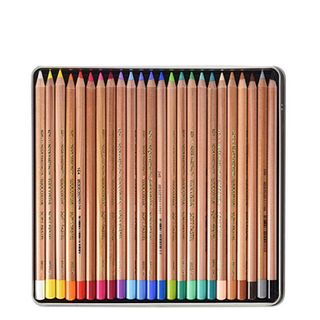The best pastel pencils offer the soft, blendable colour of pastels but in a familiar and user-friendly pencil form. This makes them easier to handle and control, both for beginners and more experienced artists, and they’re less messy, too.
Below, we’ve gathered together the best pastel pencils on the market for a variety of uses. To compile this list, we’ve got hands-on with a wide range of pencils and evaluated them in terms of binding, application, lightfastness, and more. Our testing process is rigorous and involves a variety of drawing techniques, along with a range of different canvas types.
The best pastel pencils available today
 Best pro
Best pro
Quality: professional
Quantity: 12–84
The best pastel pencils for professionals are pricey but deservedly so. Richly pigmented, nearly all 84 colours have high lightfastness ratings. Smooth going down, they leave dense colour. Harder than a soft pastel, the core is quite thick. The hexagonal barrel means the pencil won’t roll away, and the wood is smooth and easy to cut.
 Best for details
Best for details
Quality: professional
Quantity: 12 – 74
On the firmer side, these have a smooth, chalky feel. They’re easy to sharpen to a good point and keep a point for longer than many others, putting them among the best pastel pencils for fine details. The colour intensity is also excellent. They tend not to blend so readily, though they transfer to the surface well. The core is a little fragile.
 Best soft
Best soft
Quality: intermediate
Quantity: 12 – 48
Koh-I-Noor’s are the best soft pastel pencils I’ve used. They’re bright and blend readily, though with some loss of intensity. With only 48 pencils, the range is narrow but offers enough for most artists. For the price, the colour is surprisingly intense and most are lightfast. The casing is good and easy to sharpen with a blade but narrow and strong enough for a sharpener.
 Best blending
Best blending
Quality: intermediate
Quantity: 12 – 63
These have a chalky feel, though I find them quite smooth going down. They blend reasonably well and leave nice, dense colour, putting them among the best pastel pencils to balance intensity and easy blending. Because of their softness, they tend to wear quite quickly and produce a fair bit of dust, so they suit bolder marks (see our full Stablio CarbOthello review for more details).
 Best value
Best value
Quality: professional
Quantity: 3 – 60
This versatile option performs well for the price point. They feel quite smooth, are well pigmented and lay down colour fairly well – they do need a bit more pressure to produce dense marks, though. This means they can get a bit dusty. In terms of softness, Pitt pastels sit somewhere in the middle: hard enough to hold a reasonable point but soft enough to blend a bit.
 Best combining
Best combining
Quality: intermediate
Quantity: 6 – 72
This softer option has a slightly chalky feel more like a traditional pastel. They readily transfer pigment on a variety of surfaces and are particularly good at blending. The round wood binding is smooth and easy to cut through. The core may be a bit too brittle to use with the range’s sharpener, so I recommend a blade. It’s a versatile, malleable option that feels closer to a pastel block – good to combine with other media.
 Best for thick marks
Best for thick marks
Quality: intermediate
Quantity: 84
Conté à Paris pastel pencils are quite a chunky pencil that is roughly in the middle regarding softness and blending. They are particularly useful for the range of marks they can make, as the thicker core can produce broader lines. They also blend quite well. They are a bit tricky to sharpen, though.
 Best for firm lines
Best for firm lines
Quality: student
Quantity: 36
General’s multipastel pencils are chalkier than some others, with a much firmer core. The hardness means that they hold their point well and require less sharpening. This makes them capable of producing some really fine details. In terms of colour, these can seem a bit washed out. The hardness also means that these pencils don’t blend much.
